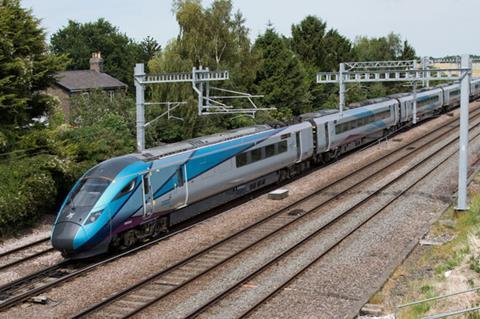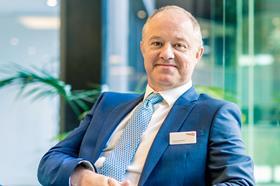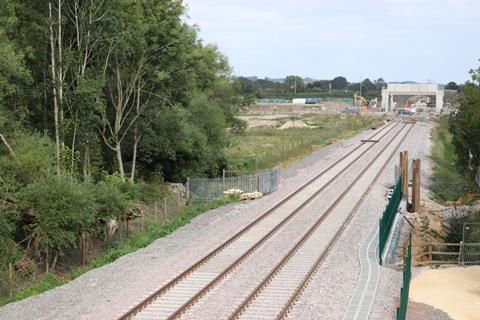
UK: ‘We in the rail sector must be objective and honest about what we are good at’, Network Rail Chief Executive Andrew Haines told a conference in Birmingham on October 3, as he reflected on how the industry can plot its way through the uncertainty of the post-Covid period.
His address to the Recalibrating Britain’s Railways event organised by consultancy Steer Group covered a gamut of challenges. Throughout the speech, Haines — who also leads the pan-industry Great British Railways Transition Team — stressed what he termed the ‘symbiotic relationship between rail and successful cities’.

‘Covid-19 reshaped economic activity in our cities, and cities are key to our economy’, he said, pointing out the uneven recovery in rail use between urban areas, citing Cardiff as an example where rail use was coming back ‘much more slowly’ than elsewhere. This reflected a clear trend towards working from home replacing the five days per week commute, which has had a dramatic impact on revenue in the passenger market.
He suggested that passenger operators are now consistently bringing in around 75% of pre-Covid revenue, when the effects of inflation and the transfer of journeys from the bus and Underground networks to the Elizabeth Line have been stripped out. While leisure travel has surged on many routes in the post-pandemic period, he reported that ‘rail revenue growth had slowed very materially in the past year’.
Making the case

Haines acknowledged that ‘improving the railway must be value for money’. The Prime Minister and the Transport Secretary ‘regularly point out’ that rail’s modal share for all journeys is less than 3%, although this rises to around 10% by distance travelled, he noted.
The pandemic effect has ‘ripped up the rule book for classic investment cases’, he added, since many of these were predicated on adding network capacity for the traditional morning and evening peaks; these peaks are less evident now than before the pandemic.
The case for making further enhancements has also not been helped by what he viewed as a failure to realise the outcomes set out in the initial business case for ‘most of the major projects undertaken in the past decade’, including Thameslink, the Great Western route modernisation and northwest electrification. ‘This does not help us to change the perception that as an industry, we ask for a lot of money and then we don’t deliver.’
Show of faith

Looking ahead, Haines felt that an ‘honest and objective’ assessment of what rail does best would be key to securing future investment.
‘Rail is demonstrably the fastest option for inter-urban travel in this country’, he emphasised. ‘It is also incredibly safe as a transport mode — maybe we need to restate that case a bit more.’
Despite the challenging outlook facing the industry at a time when political support is perceived to be waning, he cautioned against industry leaders adopting a mindset of decline. ‘It is far too easy in my opinion to just ignore the good things we are getting on with today’, he insisted, citing the ongoing funding for the Transpennine Route Upgrade as an example.
‘TRU is a £10bn investment backed by the government and by the regional authorities. How can we just ignore that and pretend such a huge sum of money isn’t being spent?’, he asked, noting that the York – Leeds – Manchester – Liverpool corridor is a route that reflects the role rail can play in connecting urban areas and delivering agglomeration benefits.
The East West Rail project to reconnect Oxford and Cambridge was a similar case, he felt. ‘It’s the macroeconomic factors that will ensure it is delivered — in 2023, you can’t unlock all that housebuilding potential in Cambridgeshire without having rail access.’
But if the rail sector is to fulfil its potential in helping cities to thrive, Haines felt the industry needs to forge stronger relationships with local authorities and regionally elected mayors in particular.
‘We have seen this week how strong the voice of local mayors can be’, he said, alluding to the defence of the High Speed 2 scheme put forward recently by the likes of West Midlands Mayor Andy Street and his counterpart in Greater Manchester, Andy Burnham. Fostering these relationships, alongside private sector investment, could help make the industry ‘less dependent’ on decision-making from the Department for Transport and the Treasury, he felt.
Setback
Concluding his remarks, Haines reiterated that ‘successful cities need rail’, and that his view was that Covid was ‘a setback, a blip’, but that nevertheless the industry ‘must respond to a changing world’.
‘Whatever is announced’ in the medium term regarding industry structure, funding and reform, ‘we all have a serious job to do’ to take the sector forward, he emphasised.



